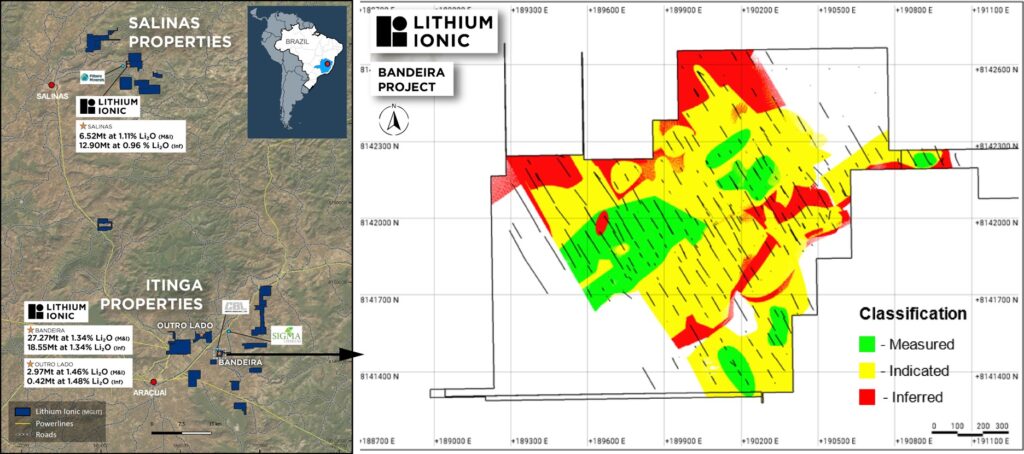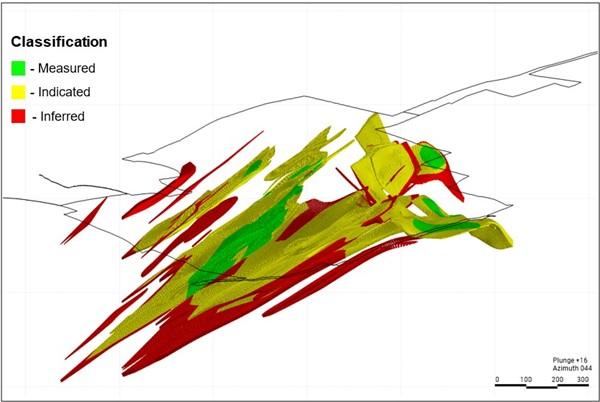
Lithium Ionic Reports Updated Mineral Resource Estimate at its Bandeira Lithium Project, Minas Gerais, Brazil; Significantly Increases Global Mineral Resources in the Lithium Valley

Lithium Ionic Corp. (TSX-V: LTH) (OTCQX: LTHCF) (FSE: H3N) is pleased to announce an updated mineral resource estimate for its 100%-owned Bandeira Lithium Project located in Minas Gerais, Brazil. Bandeira is the Company’s flagship property, located in Brazil’s “Lithium Valley”, a rapidly emerging hard rock lithium district renowned for its significant concentration of lithium-bearing pegmatites.
Prepared in accordance with National Instrument 43-101 by independent consultants, GE21 Consultoria Mineral Ltda. the updated MRE reflects continued growth and resource conversion across the deposit, underscoring the scale, geological continuity, and long-life potential of Bandeira as it advances toward development.
Bandeira Project – Mineral Resource Estimate Highlights
- Measured and Indicated MRE of 27.27 million tonnes grading 1.34% Li₂O, containing 901,059 tonnes of lithium carbonate equivalent; with an additional Inferred MRE of 18.55Mt grading 1.34% Li₂O, or 615,432 tonnes of LCE (see Table 1).
- M&I growth represents a 30% increase in tonnage compared to the MRE used in the Company’s Feasibility Study announced on May 29, 2024, and a 15% increase compared to the MRE announced on April 12, 2024.
- The updated MRE is based on 297 drill holes (60,301 metres), drilled between April 2022 and September 2024.
- The MRE maintains consistent grade while expanding tonnage, reflecting strong continuity and growth potential.
- The updated Bandeira MRE increases the consolidated, global mineral resources to 36.76 Mt grading 1.31% Li₂O in the M&I category, in addition to 31.87 Mt grading 1.19% Li₂O in the Inferred category (see Figure 1).
- The Company plans to integrate the new MRE into an updated Feasibility Study, expected in H2 2025.
*See press release dated January 14, 2025, for details related to the Baixa Grande MRE (effective date of December 2, 2024; QP: Leonardo Soares, P.Geo., M.Sc., of GE21), and the NI 43-101 compliant technical reports related to the Outro Lado deposit titled “Mineral Resource Estimate for Lithium Ionic, Itinga Project” (effective date of June 24, 2023; authored by Maxime Dupéré, B. Sc., P.Geo. and Faisal Sayeed, B. Sc., P.Geo).
Blake Hylands, P.Geo., CEO of Lithium Ionic, commented, “Bandeira continues to grow substantially while maintaining consistent grade, further validating its robustness and scale potential. This updated resource supports our mine planning efforts and will be an important input as we work through detailed engineering and evaluate future production scalability.”
Carlos Costa, P.Geo., Lithium Ionic’s VP of Exploration, commented, “Since we first began exploration at Bandeira in April 2022, the Project has consistently exceeded our expectations. What started with just two promising rock samples has evolved into one of the largest spodumene-rich pegmatite deposits in the Jequitinhonha Valley. I am extremely proud of the capability, dedication, and achievements of our entire exploration team, and we believe there is still significant potential ahead.”
The NI 43-101 technical report for the Bandeira MRE (the “Technical Report”), will be accessible on SEDAR+ (www.sedarplus.ca) under the Company’ issuer profile, and on the Company’s website, www.lithiumionic.com, within 45 days of this news release.
About the Bandeira Project
Bandeira covers 158 hectares, less than 1% of Lithium Ionic’s 17,000-hectare land position, but has rapidly advanced to become one of the most promising lithium development-stage assets in Brazil. It is located adjacent to Sigma Lithium’s Grota do Cirilo and Barreiro projects and directly beside Companhia Brasileira de Lítio’s (CBL) long-standing underground lithium operation.
The Company has also established NI 43-101 compliant mineral resource estimates at two additional properties within the “Lithium Valley”, Baixa Grande (formerly Salinas) and Outro Lado. Together, these assets bring Lithium Ionic’s consolidated global mineral resource base to 36.76 million tonnes (“Mt”) (1,188,473 LCE) in the Measured and Indicated category, in addition to 31.87 Mt (936,196 LCE) in the Inferred category, with the majority of the Company’s regional land package remaining largely unexplored.
A NI 43-101 compliant feasibility study (the “Feasibility Study”, the “Study”) for Bandeira was announced on May 29, 2024, which outlined strong project economics, including a post-tax NPV8% of US$1.31 billion and an IRR of 40%. This Study was based on a smaller MRE with a data cut-off of November 13, 2023. This Feasibility Study remains valid and will be part of the forthcoming Technical Report, however the Company intends to integrate the expanded MRE into an updated Feasibility Study in the second half of 2025. On April 2, 2025, the Company engaged the globally recognized lithium advisory firm, RTEK International DMCC (“RTEK”), to help transition Bandeira from feasibility to construction and operations.
Table 1 – Bandeira Lithium Project Mineral Resource Estimate
| Deposit / Cut-Off Grade |
Category | Resource (Mt) |
Grade (% Li2O) |
Contained LCE (kt) |
| Bandeira (0.5% cut-off) |
Measured | 3.36 | 1.38 | 114.7 |
| Indicated | 23.91 | 1.33 | 786.4 | |
| Measured + Indicated | 27.27 | 1.34 | 901.1 | |
| Inferred | 18.55 | 1.34 | 614.7 | |
- The Mineral Resource Estimation (MRE) effective date is November 20, 2024.
- The MRE has been prepared by Carlos J. E. Silva (MAIG #7868) in conformity with the CIM Estimation of Mineral Resource and Mineral Reserves Best Practices guidelines.
- The report adheres to the Canadian Securities Administrators’ NI 43-101 requirements.
- Mineral resources are not mineral reserves and have not demonstrated economic viability. There is no certainty that any portion of the mineral resource will be converted into a mineral reserve.
- Figures are rounded to appropriate levels of precision, and discrepancies may occur due to rounding.
- The spodumene pegmatite domains were modelled using composites with Li₂O grades exceeding 0.3%.
- Grade estimation was conducted using Ordinary Krigging within Leapfrog software.
- The MRE is confined to the Lithium Ionic Bandeira Target Claims (ANM) and includes only fresh rock domains.
- The MRE was constrained by the Reasonable Prospects for Eventual Economic Extraction (RPEEE) using a grade shell with a cut-off of 0.5% Li₂O for underground resources.
- Inferred mineral resources are conceptual in nature and can only form the basis for economic analyses with further drilling and evaluation.

Figure 1. Bandeira Project Location

Figure 2. Isometric View of the Bandeira Deposit
Details related to the calculation of the MRE
The MRE was prepared by Carlos Silva P.Geo., M.Sc., of GE21 (the “Author” or “QP”) with an effective date of November 20, 2024.
The MRE was prepared using the following geological and resource block modeling parameters which are based on geological interpretations, geostatistical studies, and best practices in mineral estimation.
The QP is not aware of any factors or issues that materially affect the MRE other than normal risks faced by mining projects in the province in terms of environmental, permitting, taxation, socio-economic, marketing, and political factors, and additional risk factors regarding inferred resources.
- The Project geology comprises Neoproterozoic age sedimentary rocks of Araçuaí Orogen intruded by fertile Li-bearing pegmatites originated by fractionation of magmatic fluids from the peraluminous S-type post-tectonic granitoids of Araçuaí Orogen. Lithium mineralization is related to concordant and discordant swarms of spodumene-bearing tabular pegmatites hosted by cordierite-biotite-quartz schists.
- Drilling conducted by Lithium Ionic included diamond core drilling of NTW (64.2mm diameter).
- Diamond core has been sampled in intervals of ~ 1 m where possible, otherwise intervals less than 1 m have been selected based on geological boundaries. Geological boundaries have not been crossed by sample intervals. ½ core samples have been collected and submitted for analysis, with regular field duplicate samples collected and submitted for QA/QC analysis.
- Drill core samples were submitted to SGS Geosol laboratories in Brazil where they were analyzed for a 31-element suite via ICP90A (fusion by sodium peroxide and finish with ICP- MS/ICP-OES). Assay data were composited to 1 m.
- The MRE was estimated from the diamond drill holes completed by Lithium Ionic from April 2022 until September 2024. Data from a total of 297 drill holes comprising 10,051 assays were included in the mineral resources model.
- The 3D modelling of lithium Mineral Resources was conducted using a minimum cut-off grade of 0.3% Li2O within a preliminary lithological model.
- The interpolation was conducted using Kriging methodology with three interpolation passes.
- The block model was defined by a block size of 12 m long by 12m wide by 4 m thick and covers a strike length of approximately 1,200 m to a maximal vertical depth of 500 m below surface.
- The MRE was classified as Measured, Indicated and Inferred Mineral Resource based on data quality, sample spacing, and pegmatite continuity. The Measured Mineral Resource was defined using a search ellipsoid of 50 m by 50 m by 30 m, and where the continuity and predictability of the mineralized units was reasonable. The Indicated Mineral Resource was defined using a search ellipsoid 100 m by 100 m by 50 m. The Inferred Mineral Resource was assigned to areas where drill hole spacing was greater than 100 m by 100 m by 50 m for all remaining blocks.
- Classification focused on spatial relation using a minimum of five composites in at least three different drill holes for the Measured and Indicated resources.
- Validation has proven that the block model fairly reflects the underlying data inputs. Variability over distance is relatively moderate to low for this deposit type therefore the maximum classification level is Indicated.
- Mineralization at the deposits extends to surface and is expected to be suitable for open cut mining; no minimum mining width was applied; internal mining dilution is limited to internal barren pegmatite and/or host rock intervals within the mineralized pegmatite intervals; based on these assumptions, it is considered that there are no mining factors which are likely to affect the assumption that the deposit has reasonable prospects for eventual economic extraction.
- It is the QP’s opinion that the current classification used is adequate and reliable for this type of mineralization and MRE.
- The MRE reported is a global estimate with reasonable prospects of eventual economic extraction.
Qualified Persons
Carlos José Evangelista Silva, MSc Geo. (MAIG membership number 7868), of GE21 is a Qualified Person as defined by NI 43-101 and has reviewed and approved the technical information and data regarding the MRE included in this news release. Mr. Silva is independent of Lithium Ionic. All other scientific and technical information in this news release has been reviewed and approved by Carlos Costa, Vice President Exploration of Lithium Ionic and Blake Hylands, CEO and director of Lithium Ionic, and both are “qualified persons” as defined in NI 43-101.
About Lithium Ionic Corp.
Lithium Ionic is a Canadian mining company exploring and developing its lithium properties in Brazil. Its flagship Itinga and Salinas projects are located in the northeastern part of Minas Gerais state, a mining-friendly jurisdiction that is quickly emerging as a world-class hard-rock lithium district. The Itinga Project is situated in the same region as CBL’s Cachoeira lithium mine, which has produced lithium for +30 years, as well as Sigma Lithium Corp.’s Grota do Cirilo project, which hosts the largest hard-rock lithium deposit in the Americas.
MORE or "UNCATEGORIZED"
Kuya Silver Confirms High-Grade Silver-Gold Vein Mineralization at Umm-Hadid with Initial Drill Results up to 1483.9 g/t AgEq over 2 Metres
Kuya Silver Corporation (CSE: KUYA) (OTCQB: KUYAF) (FSE: 6MR1) is... READ MORE
First Phosphate Closes Final Tranche of Oversubscribed Private Placement
First Phosphate Corp. (CSE: PHOS) (OTCQX: FRSPF) (FSE: KD0) is... READ MORE
GFG Receives Final Payment from the Sale of its Rattlesnake Hills Gold Project
GFG Resources Inc. (TSX-V: GFG) (OTCQB: GFGSF) announces that i... READ MORE
Goliath Receives $1,730,882 Through Warrant Exercises, Inclusive Of Crescat Capital A Longtime Strategic And Cornerstone Shareholder
Goliath Resources Limited (TSX-V: GOT) (OTCQB: GOTRF) (FSE: B4IF)... READ MORE
Robex Pours First Gold at Kiniéro on Schedule and Budget
Highlights: Gold bar weighing 2.64 kilograms (85 oz) poured in th... READ MORE












